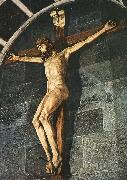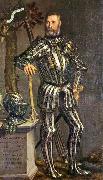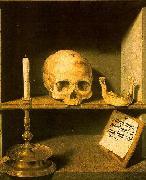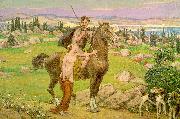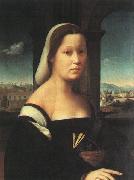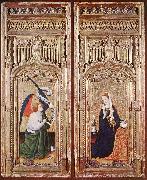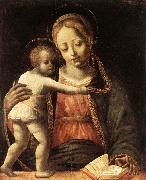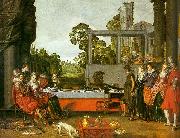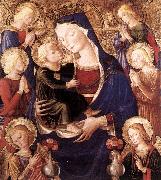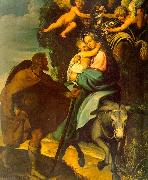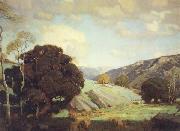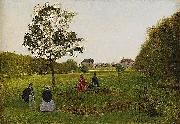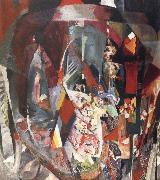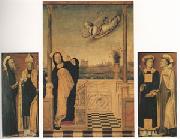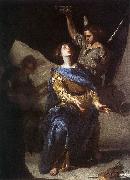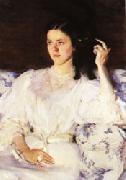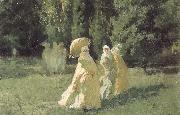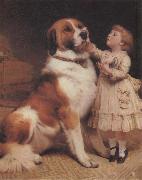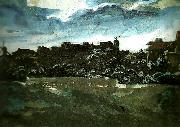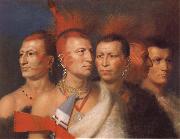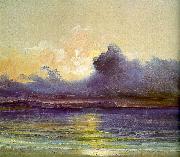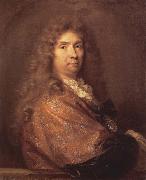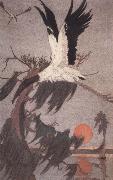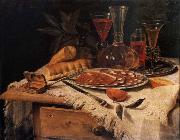|
|
|
|
 |
bruno liljefors
|
|
Bruno Andreas Liljefors (1860-1939) was a Swedish artist, the most important and probably the most influential wildlife painter of the late nineteenth and early twentieth century.[1] He also drew some sequential picture stories, making him one of the early Swedish comic creators.
Liljefors is held in high esteem by painters of wildlife and is acknowledged as an influence, for example, by American wildlife artist Bob Kuhn.[1] All his life Liljefors was a hunter, and he often painted predator-prey action, the hunts engaged between fox and hare, sea eagle and eider, and goshawk and black grouse serving as prime examples.[1] However, he never exaggerated the ferocity of the predator or the pathos of the prey, and his pictures are devoid of sentimentality.
The influence of the Impressionists can be seen in his attention to the effects of environment and light, and later that of Art Nouveau in his Mallards, Evening of 1901, in which the pattern of the low sunlight on the water looks like leopardskin, hence the Swedish nickname Panterfällen.[1] Bruno was fascinated by the patterns to be found in nature, and he often made art out of the camouflage patterns of animals and birds. He particularly loved painting capercaillies against woodland, and his most successful painting of this subject is the largescale Capercaillie Lek, 1888, in which he captures the atmosphere of the forest at dawn. He was also influenced by Japanese art, for example in his Goldfinches of the late 1880s.[1]
During the last years of the nineteenth century, a brooding element entered his work, perhaps the result of turmoil in his private life, as he left his wife, Anna, and took up with her younger sister, Signe, and was often short of money.[1] This darker quality in his paintings gradually began to attract interest and he had paintings exhibited at the Paris Salon.
He amassed a collection of animals to act as his living models. Ernst Malmberg recalled:
The animals seemed to have an instinctive trust and actual attraction to him...There in his animal enclosure, we saw his inevitable power over its many residents??foxes, badgers, hares, squirrels, weasels, an eagle, eagle owl, hawk, capercaillie and black game.[1]
The greatness of Liljefors lay in his ability to show animals in their environment.[1] Sometimes he achieved this through hunting and observation of the living animal, and sometimes he used dead animals: for example his Hawk and Black Game, painted in the winter of 1883-4, was based on dead specimens, but he also used his memory of the flocks of black grouse in the meadows around a cottage he once lived in at Ehrentuna, near Uppsala. He wrote:
The hawk model??a young one??I killed myself. Everything was painted out of doors as was usually done in those days. It was a great deal of work trying to position the dead hawk and the grouse among the bushes that I bent in such a way as to make it seem lively, although the whole thing was in actuality a still life.[1]
|
|
|
|
|
|
|
|
|
|
|
|
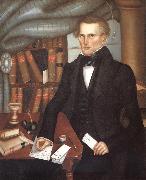 |
Bundy Horace
|
|
American portraits and landscapes painter, 1814-1883 |
|
|
|
|
|
|
|
|
|
|
|
|
|
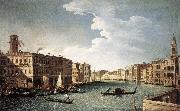 |
CANAL, Bernardo
|
|
Italian painter, Venetian school (b. 1664, Venezia, d. 1744, Venezia) |
|
|
|
|
|
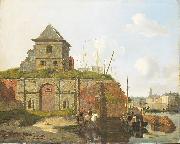 |
Carel Jacobus Behr
|
|
(9 July 1812 in The Hague - 11 November 1895) was a Dutch painter, watercolorist and draftsman. He was a pupil of Bartholomeus Johannes van Hove and mainly painted cityscapes, genre scenes and portraits.
In 1836 he produced, commissioned by The Hague municipal government, an image of the town hall there, which carried off the approval of connoisseurs. In 1837 he became a member of the Royal Academy in Amsterdam. His work is found in various collections and different exhibitions, like at the Hague in 1839, Rotterdam in 1840 and again at the Hague in 1841.
|
|
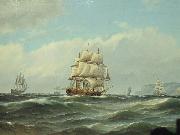 |
Carl Bille
|
|
painted Shipping off the Norwegian Coast in 1889 |
|
|
|
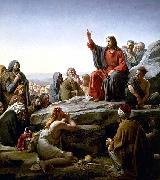 |
Carl Heinrich Bloch
|
|
(May 23, 1834 C February 22, 1890) was a Danish painter.
He was born in Copenhagen and studied with Wilhelm Marstrand at the Royal Danish Academy of Art (Det Kongelige Danske Kunstakademi) there.
His early work featured rural scenes from everyday life. From 1859 to 1866, Bloch lived in Italy, and this period was important for the development of his historical style.
His first great success was the exhibition of his "Prometheus Unbound" in Copenhagen in 1865. After the death of Marstrand, he finished the decoration of the ceremonial hall at the University of Copenhagen.
He was then commissioned to produce 23 paintings for the Chapel at Frederiksborg Palace. These were all scenes from the life of Christ which have become very popular as illustrations. The originals, painted between 1865 and 1879, are still at Frederiksborg Palace. |
|
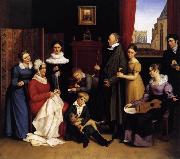 |
Carl Joseph Begas
|
|
Carl Joseph Begas (September 30, 1794 - November 24, 1854), was a German historical painter born at Heinsberg near Aachen. His father, a retired judge, destined him for the legal profession, but the boy's tastes pointed definitely in another direction. Even at school he was remarked for his wonderful skill in drawing and painting, and in 1812 he was permitted to visit Paris in order to perfect himself in his art.
He studied for eighteen months in the atelier of Antoine Jean Gros then began to work independently. In 1814 his copy of The Madonna della Sedia was bought by the king of Prussia, who was attracted by the young artist and did much to advance him. He was engaged to paint several large Biblical pictures, and in 1825, after his return from Italy, continued to produce paintings which were placed in the churches of Berlin and Potsdam. Some of these were historical pieces, but the majority were representations of Scriptural incidents. Begas was also celebrated as a portrait-painter, and supplied to the royal gallery a long series of portraits of eminent Prussian men of letters. At his death he held the post of court painter at Berlin.
|
|
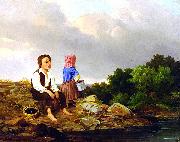 |
Carl Ludwig Brandt
|
|
(22 September 1831 Holstein, Germany - 1905) was a German-born artist who worked mostly in the United States.
Brandt was born near Hamburg, in Holstein, Germany. His father and grandfather were physicians in Hamburg. His father taught him drawing at the age of seven, and he subsequently studied in the principal galleries of Europe. He served in the First War of Schleswig (1848-1850), between Germany and Denmark.
He came to the United States in 1852. He painted several portraits previous to 1864, and in that year built his studio in Hastings-on-Hudson, New York, but lived in Europe from 1865 until 1869. He was chosen a national academician in 1872, and in 1883 was elected first director of the Telfair Academy of Arts and Sciences, Savannah, Georgia, where he resided in winter. At Telfair he offered art instruction and oversaw art acquisitions, including plaster casts, thus transforming a family mansion into a cultural institution.
|
|
|
|
|
|
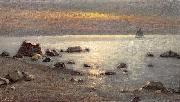 |
Carl Wilhelm Barth
|
|
(1847 - 1919) was a Norwegian painter.
He was born in Christiania. He studied painting under Hans Gude from 1881 to 1883, and having worked as a naval officer until then, he specialized in marine art. He is represented with three works in the National Gallery of Norway.
He was the son of Jacob Bøckmann Barth and brother of Agnar Johannes Barth, both foresters.
|
|
|
|
 |
Carlo Bonavia
|
|
was an Italian painter known for idyllic landscape paintings, engravings and drawings. He was active from 1740 until his death in 1788. He is thought to be from Rome, but worked in Naples from about 1751 to 1788. He was trained in the Neapolitan landscape tradition of Salvator Rosa (1615-1673) and Leonardo Coccorante (1680-1750), but was much more strongly influenced by the work of Claude Joseph Vernet, who visited Naples in 1737 and 1746. |
|
|
|
|
|
|
|
|
|
|
|
|
|
|
|
|
|
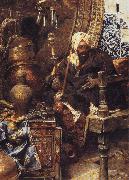 |
Charles Bargue
|
|
(c. 1826/1827?CApril 61883) was a French artist, a lithographer as well as a painter, who devised a drawing course.
Charles Bargue is mostly remembered for his Cours de dessin, one of the most influential classical drawing courses conceived in collaboration with Jean-L??on G??rôme. The course, published between 1866 and 1871 by Goupil & Cie, and composed of 197 lithographs printed as individual sheets, was to guide students from plaster casts to the study of great master drawings and finally to drawing from the living model.
Among the artists whose work is based on the study of Bargue's platework, is Vincent van Gogh who copied the complete set in 1880/1881, and (at least a part of it) again in 1890. |
|
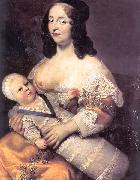 |
Charles Beaubrun
|
|
(Charles Bobrun) (1604 - 1692) was a French portrait painter active in Paris between 1630-70.
Charles Beaubrun was born at Amboise, a member of a distinguished family of painters. He studied under his uncle Louis Beaubrun (d. 1627). He and his cousin Henri Beaubrun (II) (1603 - 1677), were portrait painters in the courts of King Louis XIII and Louis XIV of France. Some of his work is jointly attributed to Henri. His youngest brother, Michel Beaubrun (d 1642), was also a painter. Charles Beaubrun died at Paris.
|
|
|
|
|
|
|
|
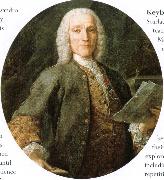 |
charles burney
|
|
Period: Classical (1750-1819)
Country: England
Born: April 07, 1726
Died: April 12, 1814 in Chelsea |
|
 |
charles de brosses
|
|
(1709-77). President of the Parlement de Dijon, friend of the philosophes, and in Diderot's words une petite tete gaie, ironique et satiriquee. His learned publications include important work on the origins of language (Traite de la formation m??canique des langues, 1765) and on primitive religion (Du culte des dieux fetiches, 1760). His Lettres familieres crites d Italie en 1739 et 1740, published posthumously in 1799 and much loved by Stendhal, offer a model of personal travel writing, in which detailed accounts of art works and monuments, not always complimentary, or a careful description of Vesuvius, addressed to Buffon, are interspersed with sprightly, enthusiastic accounts of the peculiarities and the aesthetic and sensual pleasures of life in Italy.
|
|
|
|
|
|
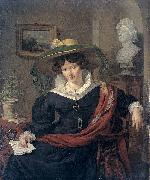 |
Charles Van Beveren
|
|
Charles van Beveren, born at Mechlin in 1809, was instructed in the rudiments of art in the academy of his native city and at Antwerp. He settled in Amsterdam in 1830, subsequently visiting Paris, Rome, and other cities of Italy, and distinguished himself as a painter of history, genre, and portraits. He died at Amsterdam in 1850. The best known of his works are:
The Confession of a Sick Girl (in the Pinakothek at Munich).
Male Figure. A study (in the Rotterdam Museum).
The Vision of St. Ignatius.
The Death of St. Anthony of Padua (in the church of Moses and Aaron at Amsterdam, his chef-d'oeuvre). |
|
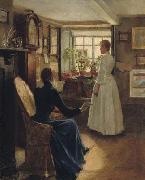 |
Charles W. Bartlett
|
|
(born 1 June 1860 in Bridport, Dorset) was an English painter and printmaker. He studied metallurgy and worked in that field for several years. At age 23, he enrolled in the Royal Academy in London, where he studied painting and etching. After three years of study in London, he entered the private studio school Academie Julian in Paris, where he studied under Jules Joseph Lefebvre (1836-1911) and Gustave Boulanger (1824-1888).
In 1889, he returned to England and married Emily Tate, but shortly thereafter, his wife and infant son died in childbirth. Bartlett then traveled to Europe, spending several productive years in Holland, Brittany and Venice with his friend and fellow artist Frank Brangwyn (1867-1956). Brangwyn is believed to have introduced Bartlett to Japanese prints. Bartlett produced some of his most important early works on the Continent, especially studies of peasants painted in broad areas of color. He was invited to join the Societe Nationale des Beaux-Arts in France in 1897. In 1898, he returned to England and married Catherine Kate Main. |
|
|
|
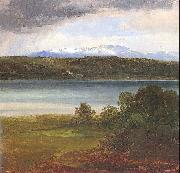 |
Christian Ernst Bernhard Morgenstern
|
|
(29 September 1805 - 12 Februar 1867) was a German landscape painter. Morgenstern is regarded as one of the pioneers in Germany of early Realism in painting. He gained this reputation in Hamburg 1826-1829 together with his contemporary Adolph Friedrich Vollmer while both were still studying; from 1830 onwards, Morgenstern, together with Friedrich Wasmann, Johan Christian Dahl and Adolph Menzel, introduced Munich to Realist painting.
Morgenstern was born in Hamburg as one of six children to a painter of miniatures, Johann Heinrich Morgenstern (1769-1813). After the early death of his father he was placed as an apprentice in the graphic workshop of the brothers Suhr. Cornelius Suhr took the young Morgenstern as his servant on a two-year journey through Germany to publicise the panorama prints which the brothers Suhr produced. 1822 followed another long journey to St. Petersburg, where they stayed for a year and to Moscow. On their return to Hamburg Morgenstern succeeded in leaving Suhr (Vollmer took his place). He became a student of the Hamburg painter Siegfried Bendixen with whom he stayed from 1824 to 1827, then continued his studies at the Royal Danish Academy of Fine Arts in Copenhagen (1827-1828) and undertook study journeys through Sweden and Norway. Bendixen introduced him to the wealthy aristocrat and supporter of the arts, Carl Friedrich von Rumohr, patron to many young Hamburg artists, on whose estate in Holstein he spent several summers. In 1830 Morgenstern went to Munich on Ruhmor's advice. He settled there permanently while undertaking extensive yearly study trips: for the first years through Bavaria, then in the summer of 1836 and in the following summers to the Alsace as guest of a patron of the arts. The winter 1839/40 he returned to Hamburg to stay with his mother. In 1841 he visited Venice and Trieste together with the landscape painter Eduard Schleich and in 1843, and again in 1846 the central Alps. In the summer of 1850 he stayed on Heligoland. |
|
|
|
|







